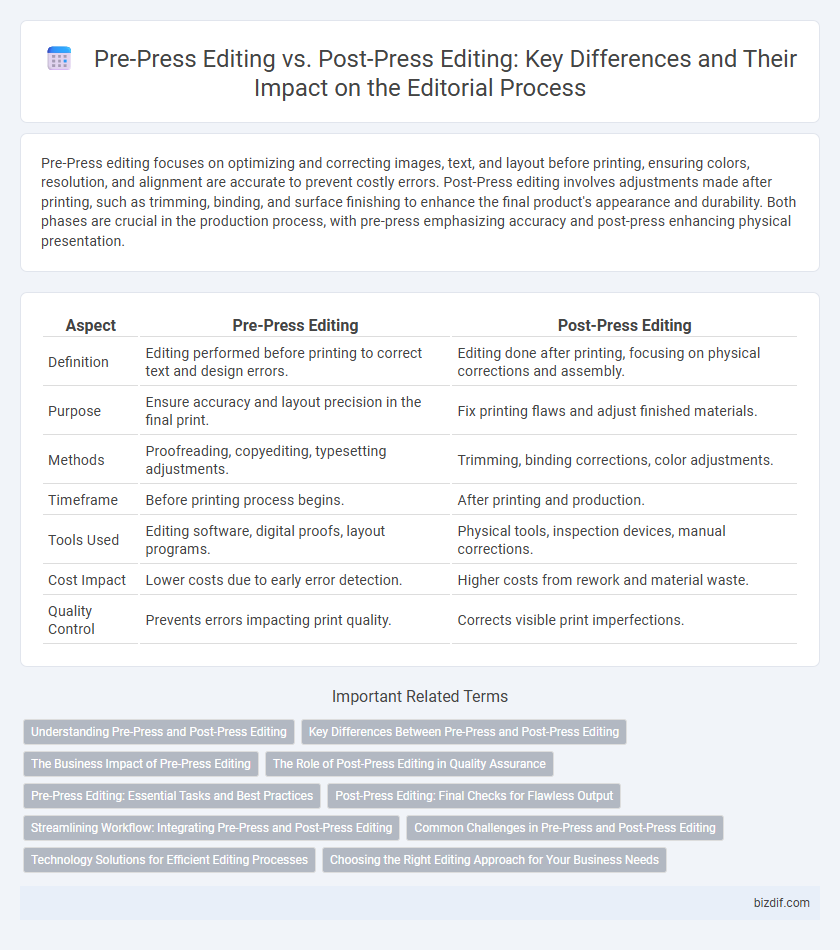Pre-Press editing focuses on optimizing and correcting images, text, and layout before printing, ensuring colors, resolution, and alignment are accurate to prevent costly errors. Post-Press editing involves adjustments made after printing, such as trimming, binding, and surface finishing to enhance the final product's appearance and durability. Both phases are crucial in the production process, with pre-press emphasizing accuracy and post-press enhancing physical presentation.
Table of Comparison
| Aspect | Pre-Press Editing | Post-Press Editing |
|---|---|---|
| Definition | Editing performed before printing to correct text and design errors. | Editing done after printing, focusing on physical corrections and assembly. |
| Purpose | Ensure accuracy and layout precision in the final print. | Fix printing flaws and adjust finished materials. |
| Methods | Proofreading, copyediting, typesetting adjustments. | Trimming, binding corrections, color adjustments. |
| Timeframe | Before printing process begins. | After printing and production. |
| Tools Used | Editing software, digital proofs, layout programs. | Physical tools, inspection devices, manual corrections. |
| Cost Impact | Lower costs due to early error detection. | Higher costs from rework and material waste. |
| Quality Control | Prevents errors impacting print quality. | Corrects visible print imperfections. |
Understanding Pre-Press and Post-Press Editing
Pre-press editing involves refining and correcting content before it goes to print, focusing on layout, color accuracy, and file preparation to ensure a flawless final product. Post-press editing occurs after printing, addressing physical issues like cutting, binding, and finishing touches to enhance the product's quality. Understanding these stages is crucial for optimizing print workflows and achieving high-quality printed materials.
Key Differences Between Pre-Press and Post-Press Editing
Pre-press editing involves refining text, layout, and design elements before printing to ensure accuracy and consistency, primarily focusing on digital proofs and file preparation. Post-press editing occurs after printing, addressing physical defects, trimming, binding corrections, and final quality checks to enhance the finished product. The key difference lies in pre-press being a preventive stage ensuring error-free digital content, while post-press is corrective, refining the tangible printed materials.
The Business Impact of Pre-Press Editing
Pre-press editing significantly reduces printing errors and costly reworks by ensuring content accuracy and design consistency before production begins. This proactive approach minimizes material waste, shortens project timelines, and enhances overall quality, leading to higher customer satisfaction and improved brand reputation. Investing in thorough pre-press editing ultimately boosts operational efficiency and lowers production costs, positively impacting a company's bottom line.
The Role of Post-Press Editing in Quality Assurance
Post-press editing plays a crucial role in quality assurance by identifying and correcting any errors or defects that occur after the printing process, such as misalignments, color inconsistencies, or cover issues. This stage ensures the final product meets professional standards and customer expectations before distribution. By addressing these last-stage imperfections, post-press editing significantly reduces the risk of costly reprints and enhances overall print quality.
Pre-Press Editing: Essential Tasks and Best Practices
Pre-press editing involves meticulous proofreading, layout adjustment, and color correction to ensure print-ready accuracy before production begins. Key tasks include verifying text consistency, checking image resolution, and confirming alignment with design specifications to prevent costly errors during printing. Best practices emphasize collaborative review processes, utilizing advanced software tools, and adhering to industry standards for file formats and color profiles to achieve optimal print quality.
Post-Press Editing: Final Checks for Flawless Output
Post-Press Editing involves thorough final checks to ensure print quality, color accuracy, and alignment are flawless after printing. This stage addresses any physical defects such as smudges, misprints, or binding errors, guaranteeing the finished product meets quality standards. Effective Post-Press Editing results in polished, professional materials ready for distribution or publication.
Streamlining Workflow: Integrating Pre-Press and Post-Press Editing
Streamlining workflow through the integration of pre-press and post-press editing enhances overall production efficiency by reducing errors and minimizing rework. Pre-press editing focuses on content accuracy, layout, and print readiness, while post-press editing addresses finishing details such as trimming, binding, and quality control corrections. Coordinating these processes ensures consistent quality, faster turnaround times, and cost-effective print production.
Common Challenges in Pre-Press and Post-Press Editing
Pre-press editing commonly faces challenges such as color calibration issues, layout inconsistencies, and file format errors that can delay production and compromise print quality. Post-press editing struggles with defects like cutting misalignments, binding errors, and surface damage that affect the final product's appearance and durability. Both stages require meticulous attention to detail and quality control protocols to ensure seamless transition from digital design to physical print.
Technology Solutions for Efficient Editing Processes
Pre-press editing utilizes advanced software tools such as Adobe InDesign and QuarkXPress to optimize layout, color correction, and text accuracy before printing, ensuring high-quality output and reducing errors. Post-press editing relies on quality control technologies like automated cutting machines and digital inspection systems to detect and correct defects in final printed materials, enhancing overall product consistency. Integrating AI-powered platforms streamlines workflows by enabling real-time collaboration and error detection across both pre-press and post-press stages, maximizing efficiency throughout the editing process.
Choosing the Right Editing Approach for Your Business Needs
Pre-press editing focuses on refining content, layout, and design before printing, ensuring accuracy and visual appeal, while post-press editing addresses corrections and adjustments after printing, often involving physical modifications. Businesses prioritizing efficiency and cost-effectiveness typically benefit from pre-press editing to minimize errors and waste, whereas those requiring flexibility for last-minute changes may opt for post-press editing. Evaluating project timelines, budget constraints, and desired precision helps determine the most suitable editing approach aligned with specific business needs.
Pre-Press Editing vs Post-Press Editing Infographic

 bizdif.com
bizdif.com